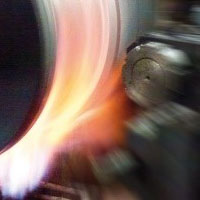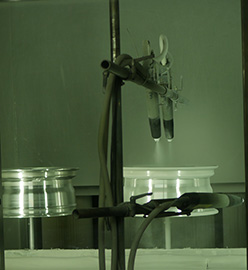Breyton Design bases all its decisions on one simple premise: Deliver the best you can possibly accomplish. We adopted the below 3 main characteristics
- Minimal weight for best driving properties. Minimal weight in this context means essentially minimal unsprung weight. This makes driving more dynamic and safe at the same time.
- Optimal strength for security and comfort. A light wheel must be strong. After all, driving security depends on it. On the side of elasticity there is another story: Comfort and performance depend on the right balance between rigidity and resistance.
- And of course the best possible look. Our wheels have to be beautiful and pure.
MOLD
 Before any wheel production can start, you need to design a high engineering mold. The mold building process is very important to ensure you have an excellent casting process later.
Before any wheel production can start, you need to design a high engineering mold. The mold building process is very important to ensure you have an excellent casting process later.
In Breyton, we have a well-rounded depth of understanding and experience in all aspects of prototyping, mold making and molding processes. And we design our own mold for our wheel designs.
RAW MATERIALS

At Breyton, we only use the best aluminium alloy (AlSi7Mg) and all incoming raw materials are subjected to stringent quality control check.
CASTING
We adopted three type of methods for Breyton different series of wheels
Gravity/ Low Pressure Casting – Design Series
Flow Forming Technology – Performance Series
Forging Technology – Forging Series
Gravity / Low Pressure Casting
 To produce a really perfect and long-lasting wheel, it is essential to have a top-quality casting blank. We use the both gravity & low-pressure aluminum casting technique to manufacture our Breyton Design Series wheels.
To produce a really perfect and long-lasting wheel, it is essential to have a top-quality casting blank. We use the both gravity & low-pressure aluminum casting technique to manufacture our Breyton Design Series wheels.
Both casting method offers balanced production cost and more visually oriented wheel design, and yet achieve the required wheel strength.
Flow Forming Technology
 Flow-forming is more sophisticated in several regards. It is more expensive than standard casting. It is arguably the most cost effective method when it comes to the production of very light aluminum wheels. Flow forming uses hydraulic rollers to achieve greater density in the material structure for the rims area of an alloy wheels. The rim area is heated over 300 to 350 degree centigrade and it is kept in a continuous rotational motion under high pressure and at high temperatures. The end result is to achieve a thinner rim wall thickness than casted one and therefore a lighter weight wheel. In addition the rim material is compressed, making the wheel very solid and improving material dynamics.
Flow-forming is more sophisticated in several regards. It is more expensive than standard casting. It is arguably the most cost effective method when it comes to the production of very light aluminum wheels. Flow forming uses hydraulic rollers to achieve greater density in the material structure for the rims area of an alloy wheels. The rim area is heated over 300 to 350 degree centigrade and it is kept in a continuous rotational motion under high pressure and at high temperatures. The end result is to achieve a thinner rim wall thickness than casted one and therefore a lighter weight wheel. In addition the rim material is compressed, making the wheel very solid and improving material dynamics.
Forged Technology
 Forging is the process of forcing a solid billet of aluminum between the forging dies under an extreme amount of pressure and compressing it in several work steps at 10,000 tons of closing pressuse This creates a finished product that is very dense, very strong and therefore can be very light. The wheel and its characteristic design are milled, using CNC processes, from a forged wheel blank. The result is far greater strength and resistance than an equivalent cast wheel.
Forging is the process of forcing a solid billet of aluminum between the forging dies under an extreme amount of pressure and compressing it in several work steps at 10,000 tons of closing pressuse This creates a finished product that is very dense, very strong and therefore can be very light. The wheel and its characteristic design are milled, using CNC processes, from a forged wheel blank. The result is far greater strength and resistance than an equivalent cast wheel.
HEAT TREATMENT
 All wheels, regardless of the applied technology, are subjected to T6 type heat treatment during production. Heat treatment increases the material’s rigidity and elasticity, making the wheel even more solid and improving material dynamics. The semi-finished wheel is heated to temperatures of 400-600 degrees C, a process to stabilization the molecular pressure.
All wheels, regardless of the applied technology, are subjected to T6 type heat treatment during production. Heat treatment increases the material’s rigidity and elasticity, making the wheel even more solid and improving material dynamics. The semi-finished wheel is heated to temperatures of 400-600 degrees C, a process to stabilization the molecular pressure.
CNC MACHINING

Breyton wheel is set on a high-speed CNC (computer numerical control) machine whereby a horizontal lathe works the wheel to required dimension. We adopted a six-point clamping system for high precision centering so to achieve minimum radial run-out in wheel industry.
COATING FINISHING
 In the final processing step, every Breyton wheel is either coated or electro-chemically anodized in multiple layers. This treatment doesn’t cause any weight increase, but protects it from corrosion and enhances wheel’s shape and mechanical workmanship.
In the final processing step, every Breyton wheel is either coated or electro-chemically anodized in multiple layers. This treatment doesn’t cause any weight increase, but protects it from corrosion and enhances wheel’s shape and mechanical workmanship.
Breyton wheel requires the application of four different layers set by heat applied epoxy powders and liquid metallic paint. Finally, a clear film lacquer coating is applied on the wheel in order to confer greater brilliance. Furthermore, meticulous quality inspections ensure that our wheels always present an absolutely immaculate surface finish.
